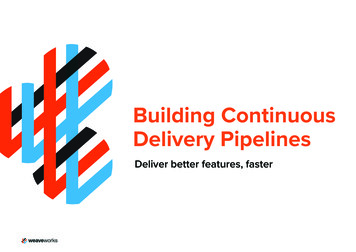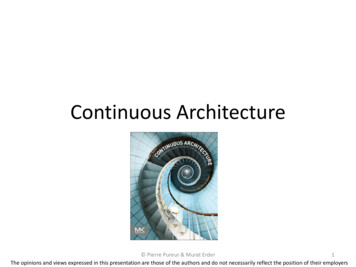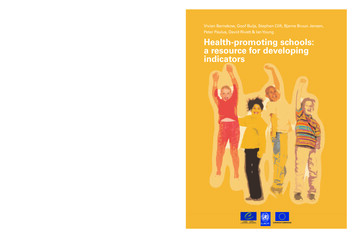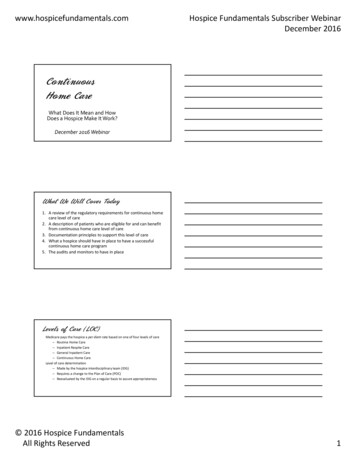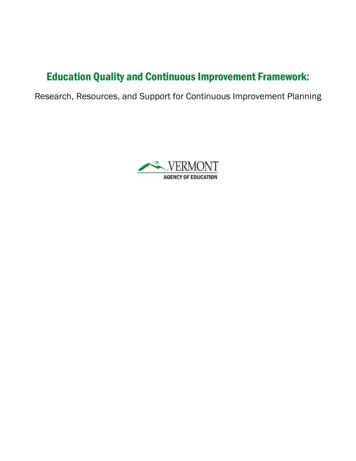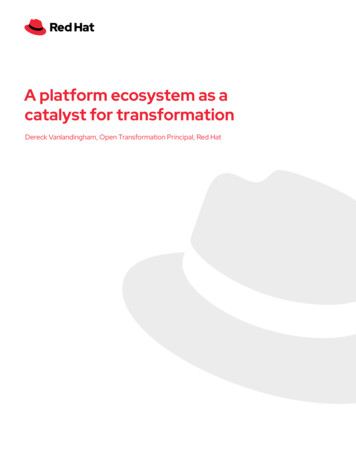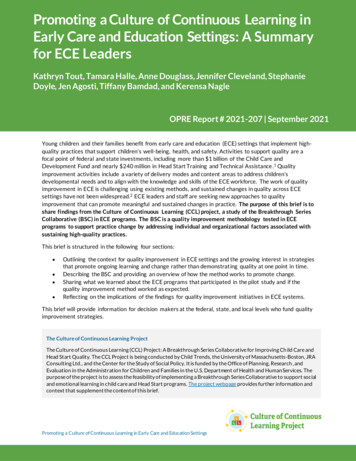
Transcription
Promoting a Culture of Continuous Learning inEarly Care and Education Settings: A Summaryfor ECE LeadersKathryn Tout, Tamara Halle, Anne Douglass, Jennifer Cleveland, StephanieDoyle, Jen Agosti, Tiffany Bamdad, and Kerensa NagleOPRE Report # 2021-207 September 2021Young children and their families benefit from early care and education (ECE) settings that implement highquality practices that support children’s well-being, health, and safety. Activities to support quality are afocal point of federal and state investments, including more than 1 billion of the Child Care andDevelopment Fund and nearly 240 million in Head Start Training and Technical Assistance .1 Qualityimprovement activities include a variety of delivery modes and content areas to address children’sdevelopmental needs and to align with the knowledge and skills of the ECE workforce. The work of qualityimprovement in ECE is challenging using existing methods, and sustained changes in quality across ECEsettings have not been widespread. 2 ECE leaders and staff are seeking new approaches to qualityimprovement that can promote meaningful and sustained changes in practice. The purpose of this brief is toshare findings from the Culture of Continuous Learning (CCL) project, a study of the Breakthrough SeriesCollaborative (BSC) in ECE programs. The BSC is a quality improvement methodology tested in ECEprograms to support practice change by addressing individual and organizational factors associated withsustaining high-quality practices.This brief is structured in the following four sections: Outlining the context for quality improvement in ECE settings and the growing interest in strategiesthat promote ongoing learning and change rather than demonstrating quality at one point in time.Describing the BSC and providing an overview of how the method works to promote change.Sharing what we learned about the ECE programs that participated in the pilot study and if thequality improvement method worked as expected.Reflecting on the implications of the findings for quality improvement initiatives in ECE systems.This brief will provide information for decision makers at the federal, state, and local levels who fund qualityimprovement strategies.The Culture of Continuous Learning ProjectThe Culture of Continuous Learning (CCL) Project: A Breakthrough Series Collaborative for Improving Ch ild Care andHead Start Quality. The CCL Project is being conducted by Child Trends, the University of Massachusetts-Boston, JRAConsulting Ltd., and the Center for the Study of Social Policy. It is funded by the Office of Planning, Research , andEvaluation in the Administration for Children and Families in the U.S. Department of Health and Human Services. Thepurpose of the project is to assess the feasibility of implementing a Breakthrough Series Collaborative to support socialand emotional learning in child care and Head Start programs. The project webpage provides further information andcontext that supplement the content of this brief.Promoting a Culture of Continuous Learning in Early Care and Education Settings1
To preview our key conclusions, the BSC has promise for ECE settings. The method is compatible with afocus on continuous improvement promoted by ECE leaders. The method is flexible enough to be used withdifferent content areas. Staff in center-based ECE programs participated in the activities and reportedengaging in the content and the quality improvement process. The research team documented initialchanges in practices that indicated increased organizational support of quality improvement and movementtoward a mindset of continuous learning. The initial findings also highlight the challenges ECE programs facethat make it difficult for them to participate in quality improvement. We offer suggestions to decisionmakers interested in implementing quality improvement methods in ECE programs. While this project wasconducted before the COVID-19 pandemic, the lessons learned provide insight into potential strategiesbeing implemented to support recovery of child care and early education programs.The Context for Quality Improvement in ECE ProgramsWhen assessed on traditional measures of observed quality in center-based classrooms, the average scoresof classrooms in child care centers and Head Start programs are in the middle- to low-ranges of themeasures.3 Teaching practices that support children’s language and concept development score particularlylow. Improving quality requires understanding the broader context for the ECE workforce and limitations incurrent quality improvement approaches.Evidence suggests that compensation and work conditions create economic insecurity and turnover among theECE workforce which may negatively impact the quality of services children and families receive.Early educators receive low wages overall, and wage disparities exist among staff of color and staff who arewhite.4 Center-based staff earn 12 per hour on average and receive minimal employee benefits.5 Morethan half of the child care workforce receives public income supports (such as the Earned Income Tax Creditor Supplemental Nutrition Assistance Program).6 Low wages are associated with increased annual turnoverin child care programs, estimated at nearly 20 percent of staff in centers.7 Compensation is also associatedwith a national staffing shortage in the wake of the COVID-19 pandemic. 8 Other conditions impacting thechild care work environment are related to job stress, burnout, and depressive symptoms. 9 Across ECEsettings, compensation and conditions for the workforce negatively affect the stability and quality ofservices provided to children and families. 10 Yet, quality improvement methods do not typically addresscompensation, benefits, and other workplace conditions that make it challenging to support the well-beingof early educators.Quality improvement opportunities typically focus on promoting compliance with standards through trainingevents or coaching rather than comprehensive approaches to implementing evidence-based practices with theunique children and families served in ECE programs.Opportunities for ECE programs to participate in meaningful quality improvement and professionaldevelopment activities differ across states, communities, and program types. For example, while most stateshave implemented a quality rating and improvement system (QRIS) for ECE programs, the range and depthof quality improvement options available to programs vary across QRIS.11 Nearly all QRIS offer coachingand consultation, but the number of hours, format, and content varies across QRIS and across programswith different needs. Fewer QRIS offer peer-to-peer learning activities, though use of this format isincreasing. QRIS typically serve child care centers and family child care programs; fewer Head Startprograms receive quality improvement supports through a QRIS, even if they have a rating. 12 Head Startprograms have access to supports from regional and national technical assistance providers, and a portionof each grant is allocated for their own training and technical assistance. Nearly all center directors in HeadStart report that they offer workshops (sponsored by their own organization or another organization); mostalso offer coaching and consultation. 13 Most Head Start teachers (80%) report receiving coaching, with themajority receiving coaching at least once per month. Head Start grantee directors are more likely toPromoting a Culture of Continuous Learning in Early Care and Education Settings2
participate in networks of leaders and leadership institutes than center directors, indicating potentialdiscrepancies in how opportunities are offered in Head Start.14Although quality improvement supports vary widely, a commonality among program types, state systems, andHead Start grantees is that quality improvement typically focuses on individuals’ skills and competencies.Coaching, consultation, and mentoring in QRIS offer strategies to help individual teachers and directorsmeet the quality standards outlined in the QRIS (including scores on observational tools). Less attention andlimited technical assistance focus on organizational structures and workplace environments that can fosterand sustain improvements over time.15 A concern among some QRIS leaders is that coaching individuals onthe standards or observational tools can result in practice changes that are not sustained because they arenot embedded in the structures and processes of the program. 16 They may also promote point-in-timedemonstration of skills instead of skills that are part of everyday routines.While quality improvement and continuous learning are prioritized and embedded in QRIS and the Head StartProgram Performance Standards, it is challenging for programs to apply these recommendations in everydaypractices.While two-thirds of QRIS offer technical assistance focused on continuous improvement, each QRIS definesand implements this focus differently. Continuous improvement may include completing an assessment andsetting goals based on assessment results but is less likely to include regular data collection andimprovement cycles to test changes in practices. The 2016 Head Start Program Performance Standardsrequire programs to engage in monitoring and continuous improvement, but evidence suggests that HeadStart programs have progress to make in using data for program improvement. 17Addressing quality improvement in the current context thus requires approaches that consider the widevariety of experiences early educators have with quality improvement and the challenges of lowcompensation, turnover, and staffing shortages. Approaches that acknowledge the importance oforganizational structures and climate, collaborative approaches, and ongoing learning would be valuable inECE systems.Creating a Culture of Continuous ImprovementQuality improvement methods used in health care and business can be applied to ECE. Research indicatestheir effectiveness and their focus on the content and the process of improvement, including developing aninfrastructure that supports quality improvement over time.18 Quality improvement methods providecontent neutral tools that can be applied across different teaching practices in ECE. The structures forimplementing the tools help build positive dynamics among program leaders and staff. By creating a positivework climate and a culture of continuous learning, changes in practice can be sustained over time.The BSC is a method developed by the Institute for Healthcare Improvement and used for nearly twodecades across health and social service settings.19 In this section we provide a simplified description of theBSC and how it was tested in ECE programs in the CCL project.aFollowing are key elements of the BSC methodology that create the conditions in ECE programs thatsupport sustained changes in practice.aFor additional technical details about the BSC, refer to other products from the CCL project including the Final -of-continuous-learning-project)Promoting a Culture of Continuous Learning in Early Care and Education Settings3
Engage ECE programs in a learning collaborativeStaff in ECE programs in one pilot community learned about the project during active outreach activities bythe CCL project team. Programs completed an application stating their interest and capacity to participate.The project team developed selection criteria and invited all seven program applicants to join the BSC. Thisengagement supported intentional decision making by the ECE program and ensured that the project teamwas equipped to meet the needs of each program joining the collaborative. Once enrolled, programsparticipated for 12 months. Participants received continuing education credits for time spent in projectactivities.Develop shared goals for changeIn consultation with local ECE experts, the CCL project team identified quality improvement goals andevidence-based practices that guided the BSC. The project team selected goals related to supportingchildren’s social and emotional learning using the Pyramid Model as a guide.20 Other options for earlychildhood content could include health and safety practices, trauma-informed care, or children’s languageand literacy. In a BSC, each selected goal is paired with metrics to show progress over time. Two monthlymetrics were selected for the project: behaviors perceived as challenging and two-way communication withfamilies.Learn in teamsTeams are an essential feature of a BSC. Each of the seven ECE programs in the BSC identified a team thatincluded teachers, directors, and parents. These teams interacted within their program and with teams fromother ECE programs in the BSC. The teams met for four full-day, in-person sessions and participated inphone calls and online forums that promoted collaboration and cross-team sharing. Teams varied in sizefrom four to eight members. Learning in teams supports participants in developing relationships that helpthem think through challenges, share successful strategies, and feel validated and respected in their work.Team work also provides peer accountability that inspires continued progress. The permission granted bythe center leader for BSC teams to test changes promotes distributed leadership and a sense of ownershipand responsibility for the improvement process.Empower and equip participants to test new practicesThe teams identified small changes in social and emotional learning practices to test. They learned new toolsfor collecting data and reflecting on if the change they tried was an improvement. Each team member wasencouraged to contribute ideas for adapting evidence-based practices for their local context. Successfulpractices were shared with non-participating staff in the program and across programs in the BSC.Provide expert support on content and the process of improvementThe BSC included experts on social and emotional learning and on the BSC process for supporting change.The experts helped the teams identify evidence-based social emotional practices to try in their classroomsand ways to determine if their practices are working. In a BSC, experts are referred to as faculty coaches.Promoting a Culture of Continuous Learning in Early Care and Education Settings4
Initial Findings: Adapting a BSC to Early Care andEducation SettingsWe examined the feasibility of implementing a BSC in center-based child care and Head Start programs byasking the following questions: To what extent did programs engage with the BSC and participate in the activities offered toteams?How successfully did programs develop a culture of continuous learning?Was there initial evidence that participating in the BSC resulted in desired outcomes related toteaching practices and organizational culture?We conducted interviews, focus groups, and surveys with participants and the team that implemented theBSC. In this section, we highlight findings from the discussions of each question and share examples of keythemes that emerged from the discussions. By design, we did not statistically test observed differencesbecause of the small number of teams that participated.Findings: Programs varied in their capacity to engage in the BSC.Participants reported that they appreciated the activities and found themdifferent from other quality improvement initiatives.A key step in ECE quality improvement is meaningful engagement of programs in improvement activities.Given the investment of time needed to participate in the BSC, it was important to assess the interest andcapacity of programs to commit to the process.Programs applied to participate in the project, but the number of applicants was smaller than expectedgiven the number of eligible programs. Potential applicants indicated interest, but they were concerned about how staff shortages andparticipation in other projects would impact their capacity to participate fully.The focus on social and emotional learning was a draw for applicants.Program participation in activities varied across programs and over time. Some programs had consistent team representation at in-person activities, while others sent onlyone or two representatives or did not attend at all.Participation in in-person activities decreased over time.Senior leaders on teams had competing responsibilities that made it difficult for some to participate.Indicators of program participation were compiled to identify two groups of programs: twoprograms with “robust” participation and five programs with “moderate” participation. Thesegroups of participants differed on other organizational characteristics, with robust participantsappearing to have greater capacity for engagement at the outset of the project.Programs completed the data collection on the monthly metrics. All programs were able to collect and submit monthly metrics data, but this process was morechallenging for some to complete on a regular basis. For example, two programs submitted only onemonth of data on children’s negative behavior.Identifying a staff person to lead the metrics collection facilitated the process.Promoting a Culture of Continuous Learning in Early Care and Education Settings5
Participants enjoyed the BSC and found it to be different from other quality improvement initiatives. Participants reported positive perceptions of the activities in the BSC.Participants valued the in-person meetings and the opportunities to interact with other teammembers through monthly calls.Participants liked the team and the faculty coaching on social and emotional learning practices.Findings: The BSC teams invested in developing a culture of continuouslearning in their programs.A culture of continuous learning is created when relationships and structures among teachers, directors,and other administrative staff in a program support curiosity, questions, and reflections about currentpractices. They are interested in learning from failures as well as successes and in learning from oneanother. The BSC focused on sparking and amplifying these mindsets and relationships.We found preliminary evidence of a culture of continuous learning in programs on multiple indicators. In some programs, teachers and directors entered the project with mindsets and organizationalpractices that support continuous learning. Measurement of these constructs showed little changeover time. This orientation toward learning and new ideas may in fact have motivated programs toapply to participate in the project.Teachers and other staff reported that they were encouraged by their BSC team to take initiativeand demonstrate leadership in trying and promoting new practices, regardless of their formal titlein the program.The teams interacted with other programs to share learning and identify opportunities to test newpractices. Working with teams in other programs exposed participants to new ideas they may nothave considered, as well as opportunities to learn from what worked well and what did not workwell in other programs.21Some personal characteristics (e.g., personal efficacy, sense of psychological safety) associated withdeveloping a culture of continuous learning appeared to differ across the robust and moderateparticipation groups. Directors’ and teachers’ beliefs in their ability to make decisions that result in positive outcomes(“efficacy”) are part of a culture of continuous learning. Directors and teachers in the robustparticipation group started high and stayed high on measures of efficacy. Directors and teachers inthe moderate participation group started lower on measures of efficacy , but scores increased overtime.Psychological safety refers to a sense of security and trust that expressing ideas is welcome in theprogram. Measures of psychological safety did not change over time; however, directors andteachers in the robust participation group started and stayed higher on the measure than those inthe moderate participation group.Findings: The project saw preliminary changes in teaching practices andorganizational culture.A key question when assessing the feasibility of a quality improvement method in ECE programs is, “Doesthe method have promise to change the outcomes of interest?” The BSC targeted (a) beliefs and practicesto support children’s social and emotional learning, (b) shared learning with non-team members, (c)knowledge and skills related to the process of making improvement, (d) features of workplace culture thatsupport continuous learning, and (e) sustained changes after participating in the BSC.Promoting a Culture of Continuous Learning in Early Care and Education Settings6
We saw preliminary evidence of changes across most but not all the outcomes of interest. As noted,statistical tests were not conducted on the observed outcomes.Beliefs about social and emotional learning Team members demonstrated little change over time on a measure of beliefs about social andemotional learning. We did not see differences in scores on the measure between the robust ormoderate participation groups. Programs with a strong orientation to social and emotional learningmay have been more inclined to apply for the CCL project than other programs.Shared learning When program teams identified successful practice changes, they shared information with otherteams. Teams adopted new practices related to, for example, family engagement strategies, optionsfor recognizing staff contributions, and techniques for supporting staff well-being under stress. Some program team members reported challenges in sharing the tools from the BSC with non-teammembers. Other team members provided examples of how they shared learning with non-teammembers in their programs.Knowledge of strategies to support continuous improvement Teams reported they had acquired new knowledge about making and sustaining improvementsusing the tools and skills obtained through the learning collaborative. Team members described how becoming familiar with data and data collection procedures helpedthem become more confident in their work and recognize that improvement is an ongoing process.Leadership and organizational culture Team members reported an appreciation for seeing members of their program demonstrateleadership, regardless of the person’s job title. Job satisfaction appeared to increase over time across teams with either robust or moderateparticipation, but different patterns were observed. Members of teams with robust participationwere higher in measures of satisfaction at both time points than those with moderate participationon all the dimensions that were measured – working conditions, co-worker relations, the workitself, and supervisor relations. Those on robust participation teams reported increases over timeon satisfaction with working conditions and supervisor relations. Those on moderate participationteams reported increases over time on satisfaction with co-worker relations and the work itself.Sustained changes Teams reported some continuation of quality improvement practices (such as collecting metrics) sixmonths after participation in the BSC ended.After examining BSC processes and outcomes, initial evidence indicates that implementing a BSC in ECEprograms is feasible and a promising strategy for addressing challenges in current quality improvementinitiatives. Though further testing of the methodology is necessary, the findings from this pilot providedecision makers with information about how challenges in ECE quality improvement can be addre ssed usinga method from the health sector. The following section offers considerations for implementing a BSC in ECEprograms.Promoting a Culture of Continuous Learning in Early Care and Education Settings7
Implications of the Findings for Quality ImprovementInitiatives in Early Care and Education SystemsThe Breakthrough Series Collaborative is a quality improvement methodology compatible with the needsand priorities of ECE programs and has the potential to fit within ECE quality improvement systems . TheCCL case study offers ECE leaders in child care and Head Start a rich example and set of considerations forwhy and how a BSC might fit in a menu of options offered to ECE programs.A key feature of the BSC is the focus on supporting evidence-based teaching practices while also addressingthe organizational processes and relationships that promote sustained change. The BSC can supportteachers in applying what they know to what they do through supportive structures that promote positiverelationships and a sense of trust and shared goals among team members. The method can be used acrossdifferent content areas and teaching practices which makes it a versatile option for the ECE system.The focus of the BSC on elevating the voices of teachers and supporting them as change agents in theirprograms also aligns with a focus in ECE on equitable practices. To fully address the needs of teachers andprogram staff, future piloting of the BSC could be combined with efforts to address wage disparities andeconomic insecurity among the ECE workforce.The CCL findings indicate that even with the enthusiasm of participants, it is important to consider howprograms with varying levels of capacity can engage in the BSC. ECE leaders can identify the additionalsupports or adaptations needed to help programs with fewer initial resources or capacity to engage in thistype of quality improvement process.Using data to track progress on monthly metrics is an activity that fits well with existing ECE practicesthough training and support would be needed to ensure that programs have the tools they need to besuccessful. The CCL project revealed challenges in collecting data, especially on a regular schedule.Programs would also need resources to address staffing and substitutes to allow them to participate in BSCactivities in an ongoing way.The CCL study also raises questions that can be addressed in future BSC implementation studies. Futurework can address the extent to which a BSC can be embedded in QRIS and Head Start TA systems and howit compares in cost and effectiveness in promoting quality improvements. The CCL study findings suggestthat certain program characteristics may be a better fit with BSC activities. An implementation study canassess options for identifying program participants and understanding how their characteristics impacttheir participation and ultimate success in a BSC.Promoting a Culture of Continuous Learning in Early Care and Education Settings8
References1Office of Child Care (OCC). (2020). Child Care and Developmental Fund Fiscal Year 2018 State Spendingfrom All Award Years. rly Childhood Learning & Knowledge Center. (2019). Head Start Program Facts: Fiscal Year 2019. U.S.Department of Health & Human Services. pdf/nosearch/hs-program-fact-sheet-2019.pdf2Tout, K., Epstein, D., Soli, M., & Lowe, C. (2015). A Blueprint for Early Care and Education QualityImprovement Initiatives: Final Report. Publication #2015-07. Minneapolis, MN: Child nstein, S., Bush, C., Aikens, N., Moiduddin, E., Harding, J. F., Malone, L., Tarullo, L., Cannon, J., Filipczak,K., & Lukashanets, S. (2019). A Portrait of Head Start Classrooms and Programs: FACES Spring2017 Data Tables and Study Design. OPRE Report 2019-10. Office of Planning, Research t/files/documents/opre/faces spring 2017 data tables a nd study design 508.pdfTout, K., Magnuson, K., Lipscomb, S., Karoly, L., Starr, R., Quick, H., Early, D., Epstein, D., Joseph, G., Maxwell,K., Roberts, J., Swanson, C., & Wenner, J. (2017). Validation of the quality ratings used in QualityRating and Improvement Systems (QRIS): A synthesis of state studies. OPRE Report, 92. Office ofPlanning, Research and iles/documents/opre/cceepra qris validation report b508.pdf4McLean, C., Austin, L. J., Whitebook, M., & Olson, K. L. (2021). Early Childhood Workforce Index 2020.Center for the Study of Child Care Employment, University of California at ldhood-Workforce-Index-2020.pdfAustin, L.J., Edwards, B., Chavez, R. & Whitebook, M. (2019). Racial Wage Gaps in Early EducationEmployment. Center for the Study of Child Care Employment, University of California at ps-in-early-education-employment/5Bureau of Labor Statistics, U.S. Department of Labor. (2021, May 17). Occupational Outlook Handbook:Childcare Workers. Bureau of Labor Statistics. hildcare-workers.htm6Whitebook, M., McLean, C., Austin, L. J., & Edwards, B. (2018). Early Childhood Workforce Index 2018.Center for the Study of Child Care Employment, University of California at n, M., Khanani, N., Zhang, X., & Parker, C. E. (2021). Center-and Program-Level Factors Associatedwith Turnover in the Early Childhood Education Workforce. REL 2021 -069. Regional EducationalLaboratory Northeast theast/pdf/REL 2021069.pdf8Haspel, E. (2020, December 9). The Other Child Care Crisis: No Staff. Early Learning other-child-care-crisis-no-staff/Promoting a Culture of Continuous Learning in Early Care and Education Settings9
9Johnson, A. D., Phillips, D. A., Partika, A., Study Team, T. T. S., & Castle, S. (2020). Everyday Heroes: ThePersonal and Economic Stressors of Early Care and Education Teacher
Quality improvement methods used in health care and business can be applied to ECE. Research indicates their effectiveness and their focus on the content and the process of improvement, including developing an infrastructure that supports quality improvement over time. 18. Quality improvement methods provide

